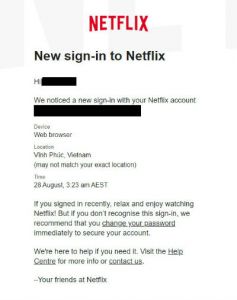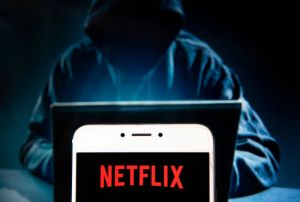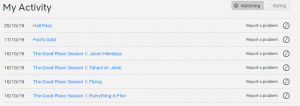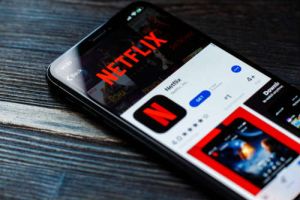If you’ve recently received a rather unnerving email from Netflix suggesting it might be time to change your password because someone has logged into your account from a far-flung country you have never even been to, let alone watched Riverdale from, it seems you’re not alone.
Responding to a new Canstar Blue survey on streaming, about one in 20 Netflix subscribers in Australia (6%) said they have experienced an issue with their account being ‘hacked’ – i.e. they had to change their password on the recommendation of Netflix.

In the example email (pictured) provided by a Canstar Blue reader, Netflix alerts the subscriber that someone has logged into their account from Vietnam, and we’re informed by said person that they definitely were not in Vinh Phuc at the time – as lovely as it sounds…
“If you signed in recently, relax and enjoy watching Netflix! But if you don’t recognise this sign-in, we recommend that you change your password immediately to secure your account,” the email reads.
That’s exactly what this particular user did. And they’re not alone. While 6% of Netflix subscribers said they have had issues with a streaming service being hacked, the number jumped to 7% of Stan subscribers, 12% for Foxtel Now and a whopping 23% for HayU!
This does not necessarily mean that HayU is the most likely streaming service to be hacked, but that people who subscribe to the reality TV platform are most likely to be affected by a hack to any subscription service, probably because they are most likely to have multiple streaming accounts. Same deal with Foxtel Now.
The results come from our survey of 1,810 Aussie adults who subscribe to one or more streaming sites.
So, what’s going on? Why would someone want to hack into your streaming account? Here’s some helpful info.

How to tell if your account has been hacked
One major telltale sign is an email like the one that’s shown above. Netflix may alert you that it has noticed suspicious activity on your account – and if you don’t recognise the address or country code, you should take action immediately.
If you haven’t received an email but want peace of mind, you can also have a stalk on your Netflix account viewing history. Simply go to ‘My Profile’ then click on ‘Viewing Activity’ which will take you to a page that outlines everything you’ve watched. If you spot anything that looks unfamiliar (make sure it’s not just a friend mooching off your account!) then you can take immediate action.


Why would someone want to hack my account?
It’s a good question. Honestly, why would someone bother? Well, it seems to be a mix of both saving money and even… making money. “It appears to be just plain old theft!” said Chet Wisniewski, principal research scientist at the security firm Sophos, to USA Today. “I don’t really see anything to it other than getting Netflix Premium.”
The article also stated that: “Hackers find Netflix series’ like ‘Stranger Things’ and ‘Diagnosis’ not just binge-worthy but steal-worthy.” We guess sometimes even hackers just need some R ‘n R time with their favourite shows.
However, other experts have warned that some more ‘experienced’ hackers could be after more than just season three of Stranger Things. An article by Forbes features a press release from cyber security company DynaRisk which states: “There are also monetary benefits; Netflix and Spotify are the perfect target for criminals who can resell stolen credentials to willing customers who want an account a fraction of the retail cost.” Even worse, “…data can be often combined with other information in an attempt to form a picture of individuals for identity theft.”
If you’re feeling a little bit overwhelmed by all of this, don’t fret, there are actions that can be taken…

What to do if your account has been hacked
First of all, don’t panic. If you still have access to your account, you need to immediately reset your password. This can be done under ‘Account’ and then ‘Membership and Billing’. If you can do this straight away, you will avoid a lot of mucking around talking on the phone.
However, if the hacker has already changed the password before you became aware, you will have to call Netflix. This can become a little more difficult – but not impossible. You will need to validate who you are over the phone by passing over your bank details that are linked to your account, and Netflix should be able to reset everything for you. There have reportedly been some instances where users couldn’t be validated and therefore had to close their old account, however that is not as common.
Another measure you may want to take is to check if your email, password or any other personal information has been leaked publically as a result of the hack. A reliable and safe way to do this is through the Have I Been Pwned service, which is a free source created so people can check to see if any of their personal information has been leaked online as a result of a hacking.
Sign up to Disney+ Australia
There are two plan options to choose from – a monthly subscription, or prepay for a year. Both plans include the same features, with unlimited downloads and the ability to stream on up to four screens at the same time. This table includes links to a referral partner.
| Brand | Subscription Type | No. of Screens/same time viewing | Advertised Cost^^/month | |
|---|---|---|---|---|
 |
min. cost $15.99 over one month |
2 | $15.99 |
Get Deal |
 |
min. cost $20.99 over one month |
4 | $20.99 |
Get Deal |
| ^^View important information | ||||
Steps to take to keep your account safe in the future
If you’re yet to experience a hack on your Netflix account (or any other streaming platform), take a look at some ways you can you become better prepared. The following suggestions are taken from Netflix’s official ‘Help Centre’.
- Use a password unique to Netflix and change it periodically. Netflix recommends using a password that is – at least 8 characters long, a mix of uppercase, lowercase, numbers and symbols, not found in the dictionary and not any personal information like birthdays, anniversaries or your address.
- Add a phone number to your account for additional security.
- Sign out of unused devices. This is especially important if you’re planning on selling a device.
- Be aware of possible phishing attempts. ‘Phishing’ is the attempt of acquiring of your personal information by pretending to represent a website or company you trust online. They may come in the form of a fake email asking for personal information (Netflix will never do this) or URLs directing you to fake websites. Be wary, and report any phishing messages to Netflix.
- Keep your computer safe and free of viruses and malware. Watch out for those dodgy pop-ups and advertisements and do not click on them. If you think your computer may be infected, you can use anti-virus software recommended by your computer manufacture or trusted IT professional.
- Report fraudulent or suspicious activity. If you notice anything out of the ordinary, contact Netflix at once.
Enough hacking talk. It’s time to get back to The Good Place. But, if you ever have to cross that bridge – we hope now that you’ll know just what to do.
Netflix, Stan, Foxtel and HayU were approached for reaction to our findings.
Image credits: Budrul Chukrut/Shutterstock.com, XanderSt/Shutterstock.com, Sitthiphong/Shutterstock.com
Original Author: Maddy Morwood


Share this article